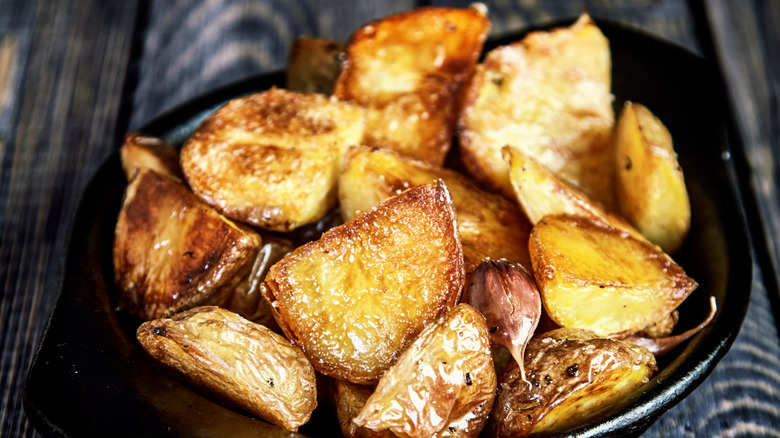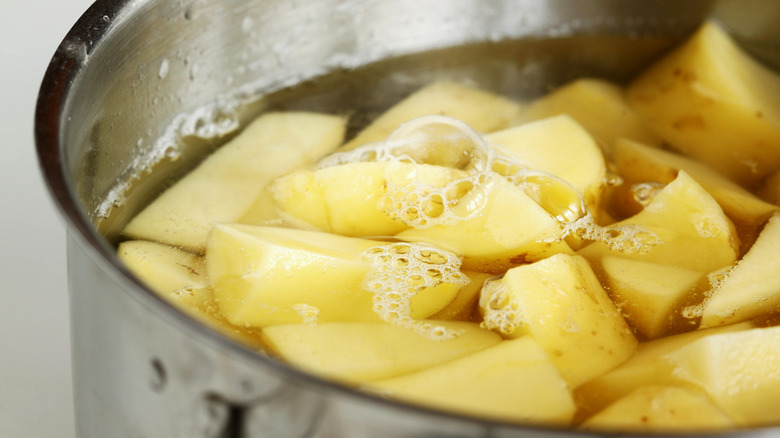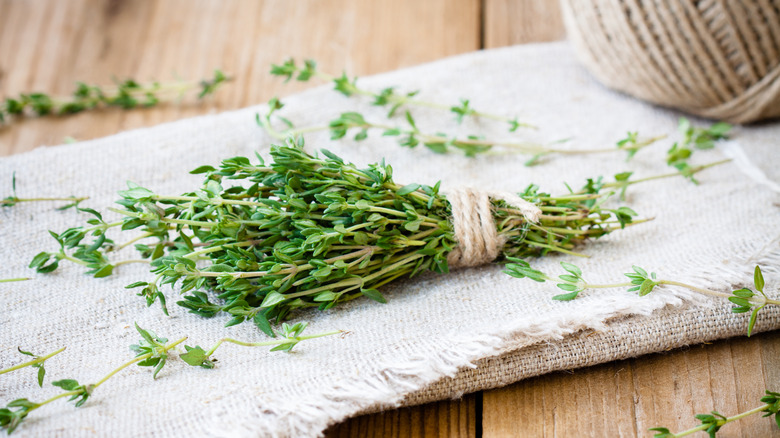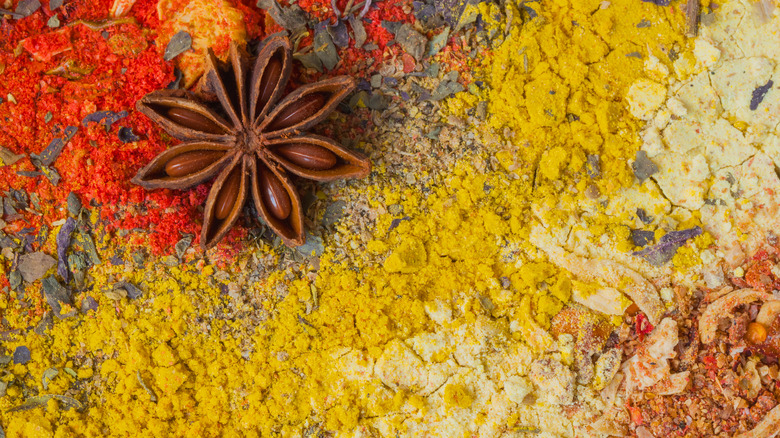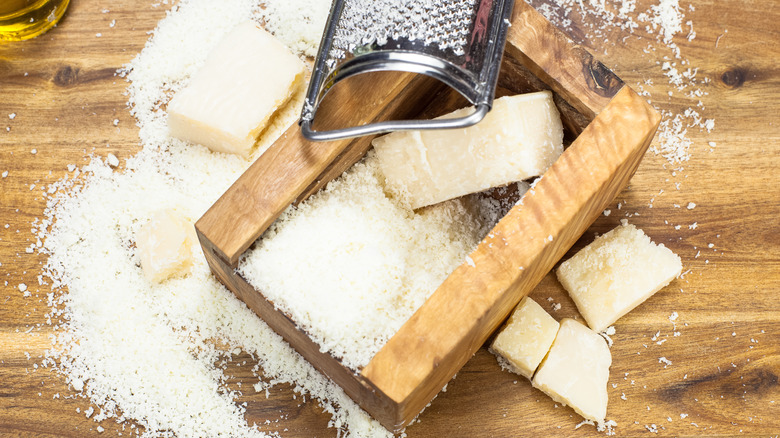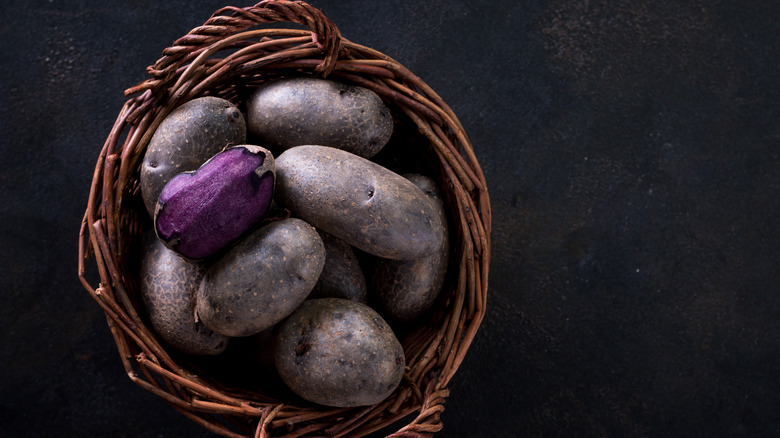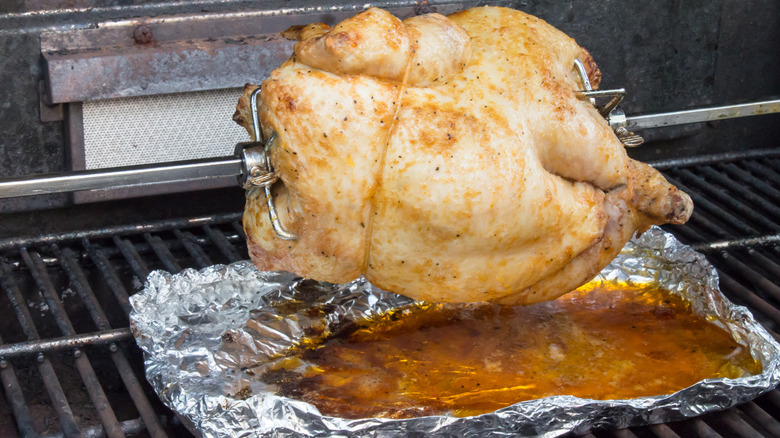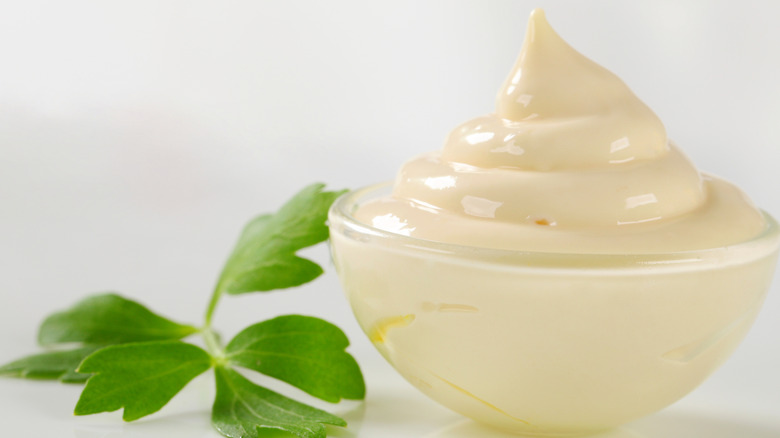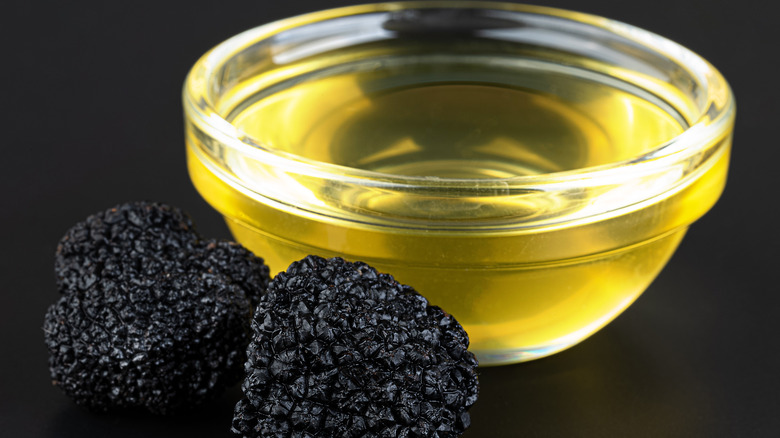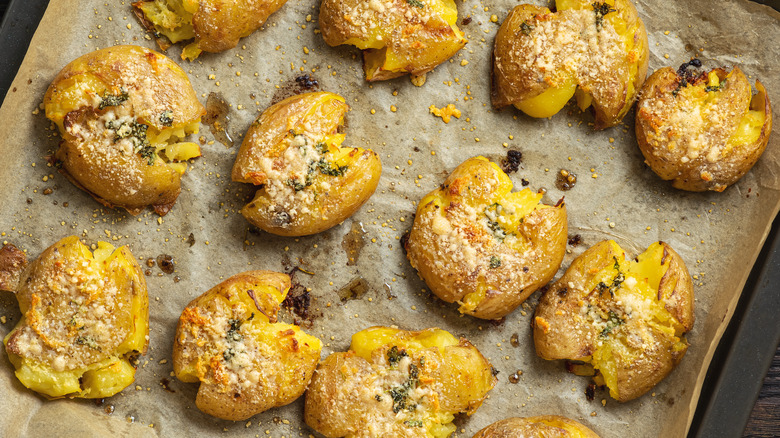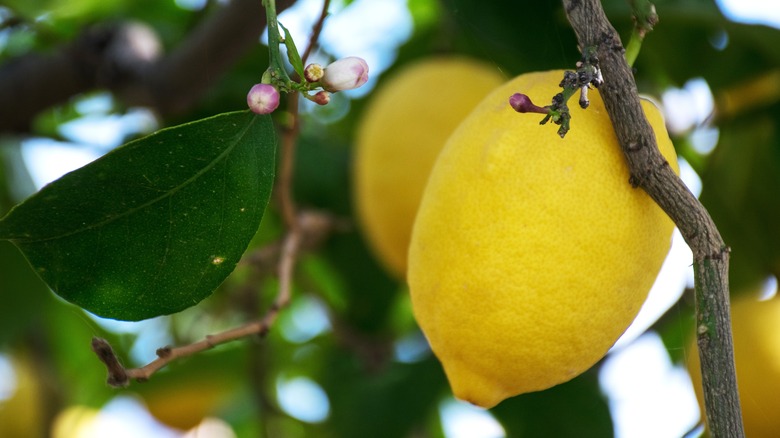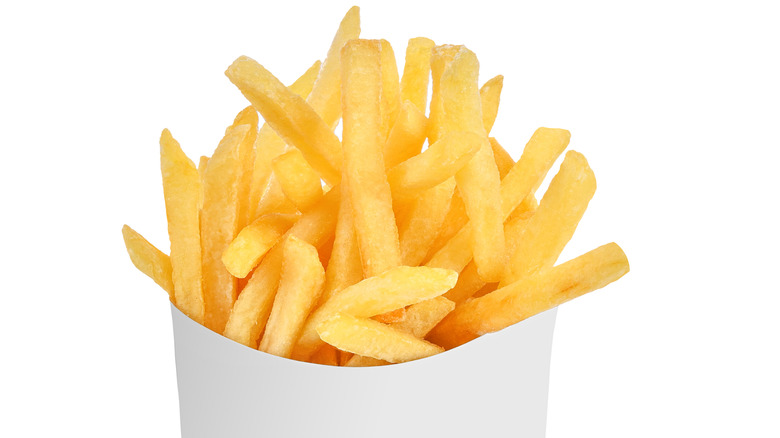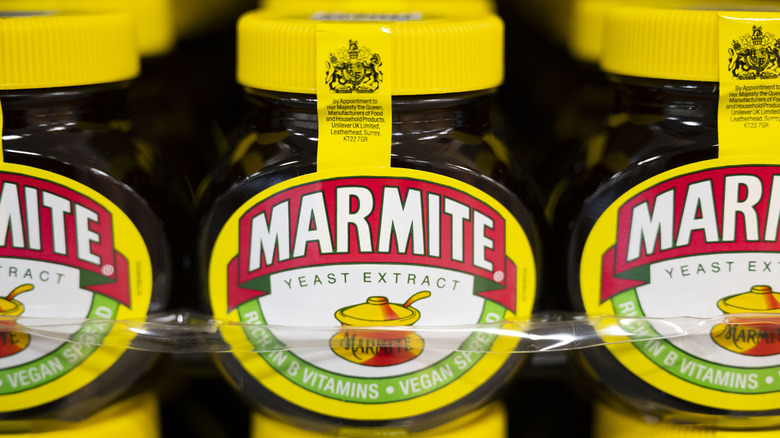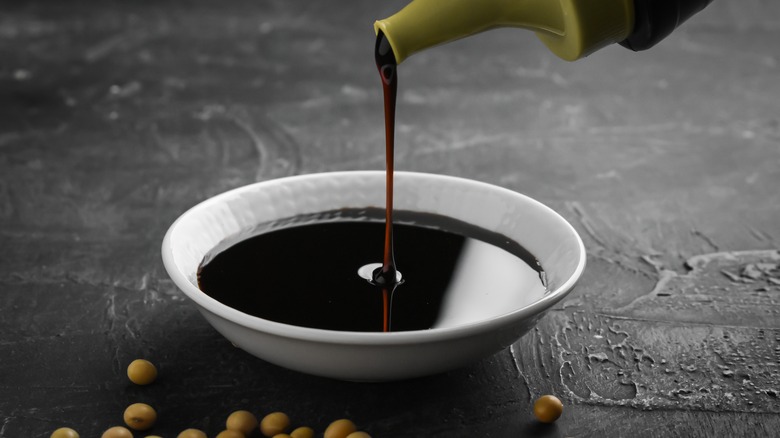13 Ways To Add More Flavor To Roasted Potatoes
It's 6 p.m. on a Monday night, and you don't know what to make for dinner. Time is running out, and your kids are getting hungry. The easiest thing to do is to dice up some potatoes and throw them in the oven. But it doesn't have to be that way — boring, that is. Those diced potatoes might look sad on their own, but if you play your cards right, you can pack such a punch of flavor in them that you'll still be tasting them the next day. And maybe the day after that. And the best part is that it's not even hard.
First of all, potatoes are pretty easy to find. High, glorious piles of them grace the supermarket aisles on any given day, so plentiful that they almost make the entire produce section look like a big, golden ball of sunshine. Second, they're easy as pie. Or easy as potato, if you will. After a few quick prep steps, they can be tossed into the oven. Lastly, they're unfailing people pleasers: They can be prepared in many different ways, paired with meat, fish, or beans, and they're naturally gluten-free.
Parboil your potatoes for maximum flavor
Seasoning isn't going to do much good if the potato's texture is all wrong. This is where a quick parboil can really come in handy. The process involves dicing the potatoes into your preferred size, then boiling them until they are partially cooked but still retain some firmness in the middle. If you have trouble remembering, think about it this way: The "par" from "parboiled" refers to the word partial. This step will bring out a layer of starch around the outside of the potatoes, which in turn, once in the oven, will transform into that magical crunch that makes roasted potatoes so endearing. (It's no wonder parboiling is key to celebrity chef Molly Yeh's perfect roast potatoes.)
If you want to be extra, super sure of getting that formidable crunch, try adding baking soda to the cooking water. This causes the pectin naturally present in potatoes to break down more quickly, bringing out even more starch and, therefore, crispiness. Once you have your crispy potato locked and loaded, nothing can stop you.
Take advantage of what's in the pantry
You have some potatoes on hand, but somehow, that doesn't seem like enough. The good news is that you don't need fancy ingredients to make your potatoes pop — you just need to play around with one or more herbs you might have leftover from a previous recipe.
How many strands of rosemary does one really need? They seem to be sold in bushes when you only need a few leaves to make a simple sauce. Chances are, then, that you have a few extra sprigs of rosemary lying around in your fridge. Don't throw them away. Simply toss them into your dish with your potatoes, olive oil, and salt, and let them work their magic in the oven. The same can be done with thyme, bay leaves, and the dried oregano that has been waiting patiently on the back of your spice rack.
Use a ready-made mix
There are so many beautiful spice blends sitting around the grocery store masquerading as single-use items. For example, let's stop putting taco mix in a corner — it can do wonders for a handful of roasted potatoes. Just preheat the oven to 400 degrees Fahrenheit, toss your potatoes, olive oil, and spice mix into a baking sheet, making sure your spuds are evenly coated, and roast for 35 to 40 minutes. If you're gluten-free and want to enjoy the flavor of ramen, dump that brick of noodles and sprinkle the spice packet on your potatoes.
If you're not much of a taco or ramen person, don't feel left out. You can make your own all-purpose spice blend ahead of time. Try playing around with a combination of chili pepper, chipotle powder, cumin, dried cilantro, sea salt, and cane sugar. Add in some grated parmesan cheese, and you'll have a really special mix. For a more sophisticated option, combine cayenne pepper, paprika, cumin, garlic powder, and powdered ginger. Such a blend has been known to pull many a meal from the brink of mediocrity with just a few flicks of the wrist.
Just add cheese
Cheese can make anything taste better, and this is especially true of potatoes. Most varieties will do the trick because cheese is generally amazing, but let's focus on the types that won't compromise that crispiness we worked so hard to achieve. Parmesan definitely fits the bill. Its crumbly, grainy texture devoid of much moisture lends itself well to a crunchy setting. All you have to do is grate it, mix it with some butter, salt, and pepper, and spread it over the bottom of your baking dish. To ensure your potatoes take full advantage of their cheesy companion, gently score them before placing them face down in the dish. Bake in the oven at 400 degrees Fahrenheit for about 40 minutes.
Another great cheese option is pecorino, which looks and acts very much like parmesan but tastes entirely different. As the name suggests ("pecora" translates to "sheep" in Italian), this cheese is made with sheep's milk instead of cow's milk, lending a saltier and more grassy flavor that pairs beautifully with crispy potatoes. To include pecorino in your roasted recipe, mix it with cornstarch and olive oil, coat your potatoes with the combo, and bake for 35 minutes at 400 degrees Fahrenheit.
Try a new type of potato
Russet and Yukon Gold potatoes can do no wrong. They're delicious, widely available, and easy to cook with. While many recipes tend to focus on these varieties, there's a whole other world of potatoes out there, just waiting to show you the true meaning of FoMO. In fact, there are thousands of different types of potatoes throughout the world. In fact, some 200 varieties of potatoes are available in the United States for cooking.
Take the Adirondack Blue potato, for example. It has a nutty, earthy flavor that will add depth to any salad while also allowing your eyes to feast on its intense indigo color. Simply roast them in the oven with some salt, pepper, and olive oil, then toss them into your salad with some greens, cherry tomatoes, and a condiment of your choice. They're also great if you're looking for a light meal and their low starch content will leave you feeling satiated but not bloated.
For truly decadent potatoes, add drippings
Fat takes to potatoes like ducks to water, so it would be a shame to keep them apart. Next time you prepare a roasted chicken or cut of beef, pour the resulting juice (or drippings) — composed mostly of fat — into a jar and set it aside. That way, when Monday night rolls around and you're looking for a way to upgrade your potatoes, you can just pull out your jar of tricks and pour it on your potatoes before cooking them in the oven as you normally would. Just make sure you give yourself enough time to return the drippings to a liquid state.
If you stored it in the fridge, as you should, it would have congealed as it cooled. This means you will have to first heat the fat in a separate pan to return it to its melted state before adding it to your potatoes. Adding animal or other types of fats to your potatoes can even give you a health boost. The British Journal of Nutrition reports that adding fat to potatoes can reduce your body's glycemic response to the tuber, keeping blood glucose levels low — where they should be.
Dunk your potatoes in mayo
Most people like mayo in one form or another, even if they don't want to admit it — perhaps as a heavy helping on a hot, juicy burger or a light film spread over bread for a BLT sandwich. Whichever camp you fall into, you'll want to dunk your potatoes in mayo before roasting them in the oven. All you have to do is literally dunk your potatoes in a jar of mayo — or if you're too polite for that, pour a generous amount of mayo over potatoes already laid out in your baking dish — mix it in well, and bake for as long and as hard as you would for your usual roasted potatoes. The fat content in the mayo will create a buffer against the heat, allowing your potatoes to cook without overdoing it. This potatoes and mayo recipe will help you add a delicious flavor while creating a bite that is soft on the inside and crunchy on the outside.
Go whole hog and add truffle oil
There may not be any bona fide truffle oil dug up by hogs (because, yes, truffle hunters sometimes use pigs to help them sniff out this delicacy) in your average store-bought bottle, but the stuff still tastes good, and you can't argue with that. All you have to do is drizzle some on your roasted potatoes after they come out of the oven. And remember, whatever you do, do not put the truffle on before roasting. Truffle oil is beautiful because it is delicate, and the high heat and longish cooking time needed to roast potatoes risks destroying much of the truffle oil's flavor. Think of it more as a finishing oil, something to add at the end to boost flavor. And if you want to really impress your dinner guests, back up your fake truffle oil with the real stuff and shave a bit of actual truffle on top of your potatoes.
Smash them up like there's no tomorrow
Some days you get back from a bad day at work and just want to let out some steam. Maybe you want to stomp your feet. Maybe it would feel good to smash something. We've got just the ticket: smashed potatoes. You can work out your stress by smashing up some potatoes. And as a bonus, when they're ready they'll look, feel, and taste delicious too. First of all, we recommend a Yukon Gold potato for this anger management exercise. The creaminess will make it more satisfying to smash. Then you'll need to boil the potatoes until completely done — we are long past parboiling here. Once the potatoes are cooked through, toss them with a mixture of salt, pepper, garlic granules and olive oil, take a flat-bottomed glass and begin smashing. Roast them in the oven for about 35 minutes, not before having brushed on a bit more of the oil mixture for good measure.
Make them summery with lemon juice
Roasted potatoes are a great winter staple. They're warm, comforting, and they make you feel all fuzzy inside. But if you want something lighter and brighter for summer, just add lemon. All you'll need are potatoes, lemons, olive oil, garlic, and dried spices. For extra lightness, swap in some dried or chopped up fresh mint and add it to your mix. Simply chop your potatoes into wedges, and follow this recipe for Lemony Roasted Potatoes. And there's a bonus to adding lemon to your potatoes: You can say goodbye to that grayish-brown color potatoes sometimes get when they've been left out for too long. The starch in the potatoes, which we normally love so much, is the culprit here: starch and oxygen combine to create oxidation, which leads to a change in color, among other things. Meanwhile, acidic substances such as lemon juice counteract the effect, leaving potatoes and other starchy produce looking snowy white!
Turn them into French Fries
You don't have to go out to a restaurant to get crunchy, crispy, real American French fries. You can make them yourself at home as if you were preparing your everyday roasted potatoes. And if you don't have a deep fryer or an air fryer, you can simply stick your French fries in the oven. The trick here is to prep the potatoes correctly. First of all, let's talk about the cut: If you want French fries, you'll have to peel and then slice your potatoes in long and thin shapes, or they won't look like the real thing. Second, you must soak your potatoes in cold water overnight, which eliminates the surface starch that tends to stand in the way of a potato becoming crispy. Only after you have done all this can you finally roast your potatoes and expect your oven to turn out French fries.
Add a secret ingredient and don't tell anyone it's Marmite
Before you run for the hills, consider that you don't have to slather it on your potatoes. You can simply add a tasteful amount, and it'll go a long way. And when you remember what's actually in Marmite, it won't sound so bad: It contains yeast extract (which itself consists of barley, wheat, oats, and rye), salt, vegetable juice (from concentrate), vitamins, and celery. Nothing too strange, in other words.
So how does it work? In one iteration of this recipe, you'll want to parboil the potatoes with Marmite in the water. Be sure to adjust the amount you add to the level of love you have for the spread. After that, continue roasting your potatoes as you normally would. Another option is to dab your potatoes with it right before they go in the oven. In both cases, you'll end up with a deep brown color and loads of flavor. And if you've never heard of Marmite until now, consider yourself lucky that you are being introduced to it like this, rather than how most of the world eats it — unceremoniously slapped across dry toast.
Take inspiration from other countries
Potatoes may be native to South America, but they have since come a long way, and there is practically no cuisine in the world that doesn't use them these days. For example, it's hard to imagine French cooking without potatoes taking center stage. Potatoes Au Gratin or creamy, heavenly mashed potatoes are well-known French staples. But Asia can certainly hold its own in terms of potato-inspired recipes. A Thai green curry can be made heartier and more filling with a few potatoes without taking away from the delicate texture of the sauce.
And then there's Korean roast potatoes. These are fried potatoes that are then boiled and braised, which creates a unique effect of extreme crunch on the outside paired with extreme fluffiness on the inside. But the real star of the show here is the sauce blend, which is made up of soy sauce, rice wine, brown sugar, and an optional hint of gochujang, a Korean paste made from chili peppers. Braising the potatoes in this sweet and salty sauce adds a real depth of flavor. To learn how to make it, this delicious, shiny Gamja Jorin recipe will do the trick.
